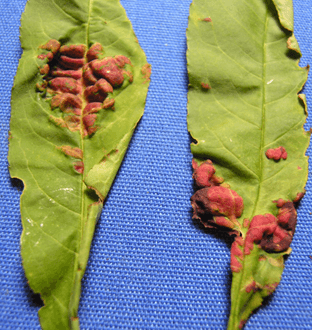Disease Notes
Contact
Plant Diagnostician
Phone: (479) 575-2727
Email: ssmith@uada.edu
Jason Pavel
Diagnostician
Phone: (479) 575-7257
Email: jpavel@uada.edu
University of Arkansas System Division of Agriculture
Cralley Warren Building
Room 16
2601 N. Young Ave.
Fayetteville, AR 72704
Peach Leaf Curl
by Sherrie Smith and Jason Pavel

Peach Leaf Curl – Taphrina deformans
Photo by Sherrie Smith, University of Arkansas Cooperative Extension Service
If you had problems with Peach leaf curl last season, you should already have sprayed after dormancy in the fall before your tree leafed out this spring. Once symptoms of Peach leaf curl are evident, it is too late to spray during the current season. Spores from the fungus Taphrina deformans overwinters on twigs and bud scales. Infection occurs at bud break early in the spring during cool, wet weather. Blister-like swellings, curling, thickening, puckering, and discoloration of the leaves are the first symptoms of Peach leaf curl. Affected areas may turn pink, red, or yellow. In severe cases, defoliation occurs along with substantial yield loss. Peach leaf curl is easily controlled with one well-timed fungicide application in the fall after 90% of the leaves have dropped, or very early in the spring before the buds begin to swell. Chlorothalonil or copper sprays are effective. It is too late for chemical control this spring, but if only a few leaves are infected, they may be handpicked and destroyed to reduce inoculum levels.
Take aways
- Too late to spray once trees’ leaf out in the spring
- Do spray in the fall after 90% of the leaves fall or in the spring before trees’ leaf out
- Copper fungicides or chlorothalonil are effective
- Handpick affected leaves and dispose of if practical
This work is supported by the Crop Protection and Pest Management Program [grant no. 2017-70006-27279/project accession no. 1013890] from the USDA National Institute of Food and Agriculture.